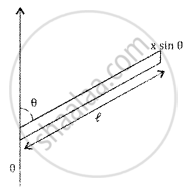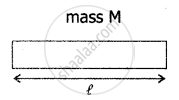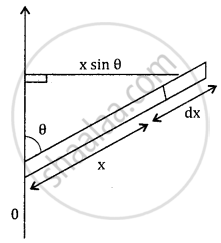Advertisements
Advertisements
प्रश्न
A uniform rod of mass m and length l makes a constant angle θ with an axis of rotation that passes through one end of the rod. Find the moment of inertia about this axis.
उत्तर


Here mass is distributed on length taking an element of small length dx at a distance x as in the figure.
dm = `M/ℓ`.dx
Moment of Inertia of small element

dI = dm.r2
dI = dm (x sin θ)2
dI = `x^2 sin^2theta. M/ℓ`dx
Total moment pf Inertia = I = `int_0^ℓ`dI
I = `int_0^ℓ x^2 sin^2theta M/ℓ dx`
I = `M/ℓ sin^2theta int_0^ℓ x^2 dx`
I = `M/ℓ sin^2theta [x^3/3]_0^ℓ`
I = `M/(3ℓ) sin^2theta [ℓ^3 - 0]`
I = `M/3ℓ^2 sin^2theta`
I = `1/3 mℓ^2 sin^2theta`
APPEARS IN
संबंधित प्रश्न
A closed cylindrical container is partially filled with water. As the container rotates in a horizontal plane about a perpendicular bisector, its moment of inertia, ______
From a disc of radius R a mass M, a circular hole of diameter R, whose rim passes through the centre is cut. What is the moment of inertia of the remaining part of the disc about a perpendicular axis passing through it?
Mention any two physical significance of the moment of inertia.
What is the radius of gyration?
Derive the expression for the moment of inertia of a rod about its centre and perpendicular to the rod.
Derive the expression for the moment of inertia of a uniform ring about an axis passing through the centre and perpendicular to the plane.
Derive the expression for the moment of inertia of a uniform disc about an axis passing through the centre and perpendicular to the plane.
State and prove parallel axis theorem.
State and prove perpendicular axis theorem.
Find the moment of inertia of a hydrogen molecule about an axis passing through its centre of mass and perpendicular to the inter-atomic axis. Given: mass of hydrogen atom 1.7 × 10-27 kg and interatomic distance is equal to 4 × 10-10 m.
